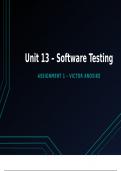Unit 13 – Software Testing
ASSIGNMENT 1 – VICT OR A NOSIKE
, Software Testing
What Is Software Testing:
The practice of examining and confirming that an application functions as intended is known as software te
executing various types of software testing, is a method that aids in the prevention of flaws in a product
well as the reduction of development expenses. Finding flaws in the early stages of a product’s develop
corrected via software testing, which can also help an organization save money in the future. To reduce
time required to rework and deliver error-free software to the client or end-user, software testing is often
early in the system’s development stage.
User Requirement:
User requirement is the process of determining the needs and desires of users and figuring out how to mee
would entail creating a system that satisfies users and incorporates features to enhance the user experienc
four types of conditions that must be met:
Functional Requirement – A task that must be achieved in order to meet operational requirements. This requ
in the identification of features and information required within the software. Functional requirements
because they allow a developer to establish which features and behaviours ensure that software functions
is comfortable for the end-user, and satisfies their expectations.
Performance Requirement – A statement outlining how a function should be conducted depending on sev
such as amount, accuracy, coverage, timeliness, and readiness. The developer would examine
requirements to guarantee that the software meets operational capabilities and that consumers can use it
The maintenance and dependability characteristics of software would be determined at this point in order
what is required to be included in order to meet the requirements for which the system is created.
. System Technical Requirements – These are the factors required for the system to output a desired
behaviour in order to meet the standards and needs of users. This can refer to how the software oper
hardware is created, all of which are characteristics that users will evaluate when using the product. This is
that developers must thoroughly comprehend in order for the programme to be tailored to the user in t
possible.
Specification – A detailed statement that describes the system's materials, scope, and overall quality
produced and placed on the product. The specification establishes the overall objective of the product,
features to be gained specifically for a product that will satisfy users while being reasonably priced. This
recognise since it offers clear instructions on the system's purpose, performance, and how to build it..
, Typical Job Roles in a Software Development Team
Software Developers – Individuals who use programming and design knowledge to creat
applications, software, and programmes to fulfil the demands of users and solve problems. This ent
with a client who requires software development and then building, testing, and deploying that
accordance with the specifications provided. There are two types of software developers today:
developers, who design or create an application internally or online, and system developers, who fo
the operating system will be utilised and work.
Software Testers – Skilled professionals who use their skills and expertise to ensure that
programme works as it should. They typically collaborate with other team members to ensure that
runs well. If this is not the case, they will execute a number of tests to validate and inspect the
such as troubleshooting for bugs or faults or validating the security of the programme to assure its in
Business Analysts – Members who are asked to assist a company in developing or improv
commercial activities and products. They undertake study and analysis to develop and implement s
company's problems. This usually entails their determining what exactly users require from a produ
so that they can feed the knowledge back to the development team. If they believe an exchang
necessary, they can also serve as a point of contact for communication between the development te
project management.
Project Managers – These are the people in charge of overseeing and managing software p
beginning to end, ensuring that everything runs smoothly and successfully. This would entail givin
presentations, writing project proposals, and motivating software developers and other team m
generate adequate outcomes. Planning the blueprints for the software project, assembling and d
project team, and tracking and budgeting are just a few of the numerous responsibilities assigned to
manager.
Product Owners – Hired stakeholders whose decisions has an impact on the work that is acco
every level of development. Their decisions have the potential to raise or decrease time consumptio
the overall success of the product. The product owner's goal is to maximise the value of the d
team's efforts in creating a high-quality product. This can be accomplished by building and managin
backlog to aid in the inspection of a product's progress, communicating the vision and goals at the s
stage, and communicating the product's status to stakeholders externally.




